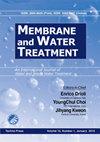Enhancement of hydrophilicity and anti-fouling property of polysulfone membrane using amphiphilic nanocellulose as hydrophilic modifier
IF 1.1
4区 工程技术
Q4 ENGINEERING, CHEMICAL
引用次数: 1
Abstract
In the present work, we present a new effective hydrophilicity modifier for polysulfone (PSf) membrane. Firstly, amphiphilic nanocellulose (ANC) with different substitution degrees (SD) was synthesized by esterification reaction with nanocellulose (NC) and dodecyl succinic anhydride (DDSA). The SD and morphology of ANC were characterized by titration method and transmission electron microscopy (TEM). Then, the polysulfone (PSf)/ANC blend membranes were prepared via an immersion phase inversion method. The influence of SD on the morphology, structure and performances of PSf/ANC blend membrane were carefully investigated by Fourier transform infrared spectroscopy (FTIR), scanning electron microscope (SEM), mechanical property test, contact angle measuring instrument and filtration experiment. The results showed that the mechanical property, hydrophilicity and anti-fouling property of all the PSf/ANC blend membranes were higher than those of pure PSf membrane and PSf/NC membrane, and the membrane properties were increased with the increasing of SD values. As ANC-4 has the highest SD value, PSf/ANC-4 membrane exhibited the optimal membrane properties. In conclusion, the prepared ANC can be used as an additive to improve the hydrophilicity and anti-fouling properties of polysulfone (PSf) membrane.用两亲性纳米纤维素作为亲水改性剂提高聚砜膜的亲水性和防污性能
在本工作中,我们提出了一种新的有效的聚砜(PSf)膜亲水性改性剂。首先,通过与纳米纤维素(NC)和十二烷基琥珀酸酐(DDSA)的酯化反应,合成了不同取代度的两亲性纳米纤维素(ANC)。用滴定法和透射电子显微镜(TEM)对ANC的SD和形态进行了表征。然后,采用浸渍相转化法制备了聚砜(PSf)/ANC共混膜。通过傅立叶变换红外光谱(FTIR)、扫描电子显微镜(SEM)、力学性能测试、接触角测量仪和过滤实验,详细研究了SD对PSf/ANC共混膜形态、结构和性能的影响。结果表明,所有PSf/ANC共混膜的力学性能、亲水性和防污性能均高于纯PSf膜和PSf/NC膜,并且膜性能随着SD值的增加而增加。由于ANC-4具有最高的SD值,PSf/ANC-4膜表现出最佳的膜性能。总之,所制备的ANC可作为添加剂改善聚砜(PSf)膜的亲水性和防污性能。
本文章由计算机程序翻译,如有差异,请以英文原文为准。
求助全文
约1分钟内获得全文
求助全文
来源期刊

Membrane Water Treatment
ENGINEERING, CHEMICAL-WATER RESOURCES
CiteScore
1.90
自引率
30.00%
发文量
0
审稿时长
>12 weeks
期刊介绍:
The Membrane and Water Treatment(MWT), An International Journal, aims at opening an access to the valuable source of technical information and providing an excellent publication channel for the global community of researchers in Membrane and Water Treatment related area. Specific emphasis of the journal may include but not limited to; the engineering and scientific aspects of understanding the basic mechanisms and applying membranes for water and waste water treatment, such as transport phenomena, surface characteristics, fouling, scaling, desalination, membrane bioreactors, water reuse, and system optimization.
 求助内容:
求助内容: 应助结果提醒方式:
应助结果提醒方式:


